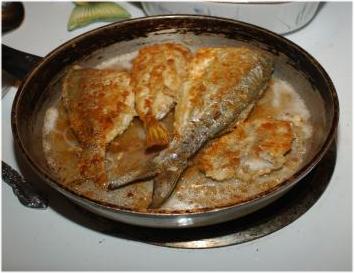| 07-19-04
Catching fish and cooking fish are two very different aspects of outdoorsing.
Success at the former does not guarantee a table-worthy latter. Yet, cooking
fish is as simple as falling off a log backwards while crossing a river.
Having grown up watching my grandmother, mother and sister (three excellent
cooks) prepare fish for the table, I learned good basic tactics for cooking
fish. Since I have been on my own in the kitchen for some 50 years, I have
refined their methods and added some cooking wrinkles of my own.
When I was a kid growing up on the two forks of the Muscatatuck River
in good ol’ Jackson County, the basic method for preparing fresh fish for
the table was frying . . . in hog lard, yet.
Pan-type fish--bluegills, crappies (pronounced croppie), goggle-eyes
and other small fish--were fried whole (heads, entrails, scales removed,
but skin still on). They were, of course dredged in yellow corn meal before
being plopped into a sizzling iron skillet to be fried to a golden brown
on both sides.
Larger fish were either “steaked” or cut crosswise with bones in the
flesh for frying. Fish dinners at our house were a thing to behold.
After World War II fish eaters learned to filet fish that were large
enough to offer two slabs of meat, and the bones were removed. However,
many of my old friends--especially those who eat saltwater species several
times each week--contend that cooking fish without the bones tends to eliminate
some of their value as wholesome food--and worse yet, their taste.
I still fry fish--whole or as filets. And I must say, I never saw a
fried fish I didn’t like. But I also bake, broil, and poach fish, not to
mention numerous variations of these methods.
However, this column (because those who publish my work do not believe
length guarantees strength) will be confined to frying fish.
In spite of the fact that grandma turned out a pretty decent fried fish
by simply rolling the damp flesh (whole or steaks) in yellow cornmeal and
frying it in an old iron skillet over a wood-burning stove, I think I have
built the proverbial “better mousetrap.”
Frankly, it pains me more than somewhat to think I could be even the
shadow of my kitchen mentors, but over the years I think I have developed
a pretty good process (I don’t like to call it a recipe) for frying fish.
My fish-frying process starts with rolling good crackers (I use Keebler
Club crackers exclusively) as fine as possible, and mix the cracker meal
half-and-half with flour. To turn whole crackers into a fine, mealy dust,
I place them in a plastic sandwich bag and allow the air to escape before
pulverizing them with a rolling pin.
When this job is finished and I have combined the cracker meal with
an equal part of flour, I break one or two eggs (the number depends upon
how much fish I will be cooking) in a shallow cereal bowl and beat them
into an equal part of milk.
While the preliminary steps of the procedure are being completed, I
fry four to six strips of bacon (jowl bacon preferred) in the iron skillet
I will use for frying the fish.
When the bacon is crisp, I place the strips on a paper towel to cool,
and stir into the bacon “fryings” (grease) enough olive oil to make the
cooking agent about 1/8 (one-eighth) inch thick in the skillet.
While the cooking agent is getting to the sizzle stage as I test it
with cracker crumbs, I salt and pepper each piece of fish liberally on
both sides. The pieces of fish then are dipped in the egg-milk, rolled
in the cracker meal/flour mixture and plopped into the skillet. Incidentally,
George Emmelman, one of the best modern-day fish cooks I know, says country
custom dictates that in frying fish one should use enough pepper to track
a rabbit.
If some of the pieces of fish tend to curl on their sides, they should
be flattened with a strong spatula. This curling tendency often occurs
with filets having skin on one side.
Once the fish is in the skillet (each piece in direct contact with the
cooking agent), the pieces should be monitored closely and individually,
and turned when well browned on the first side. When each piece is well
browned (not burned) on the second side, it should be removed.
Fried fish is best when consumed hot--or at least warm. However,
this thinking does not preclude the fact that, for a lover of fish, eating
leftovers from the frig is a bit like eating good candy.
What happens to the bacon? Crumbled crisp bacon can will give a green
salad extra zip, but C’s P (cook’s prerogative) places the bacon in the
hands (or tummy) of the cook if he/she can’t wait for dinner.

The fastest
and easiest way to cook fish is frying. Four ocean species grace this fry
pan. Left to right they are whole spot, chicken of the sea, bluefish and
a chunk of pompano.
|

